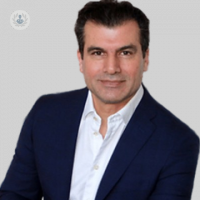Hybrid augmentation: Enhancing breast surgery
Autore:When it comes to breast surgery, the primary goal is to create a breast size and shape that compliments the patient's overall figure. This involves a careful consideration of proportion, ensuring the results are neither too understated nor overwhelming. Mr Rezai, a distinguished surgeon in the field, meticulously evaluates factors such as the patient's height, weight, shoulder and hip width, breast width and height, and the distance between the nipple and breast fold. Additionally, the patient’s preferences regarding upper and lower breast pole volume play a critical role in determining the most suitable implant type, size, and surgical technique.

The combined approach: Enhancing natural breast tissue with fat transfer
In situations where a patient lacks sufficient natural breast tissue, Mr Rezai employs a hybrid method, combining fat transfer with implant augmentation. This technique significantly enhances the look and feel of the breast, particularly in the medial, lateral, and inferior regions. The muscle already covers the upper pole; thus, the hybrid method contributes to a more natural appearance and texture by adding volume where it is most needed.
Fat transfer in breast reconstruction
Fat transfer has long been a staple in breast reconstruction surgeries. It effectively corrects asymmetries and reshapes breasts in individuals with deformities, fills defects post-lumpectomy, and can even be used for total breast reconstruction following a mastectomy. However, achieving sufficient volume through fat transfer alone often necessitates multiple surgeries. Hybrid augmentation provides a superior solution by combining implants and fat transfer, thereby achieving the desired volume with fewer procedures. The transferred fat acts as a cushion between the implant and skin, especially in patients with minimal natural breast tissue, resulting in a more natural look and feel.
Cosmetic enhancements with hybrid augmentation
The hybrid augmentation technique is similarly beneficial in cosmetic breast enhancements. It helps create a natural look and feel for patients who either lack natural breast tissue or have lost it due to severe capsular contracture from previous implants. It also addresses volume asymmetry and smooths out contour irregularities. In traditional implant augmentations, Mr Rezai usually presents three implant sizes to patients—one for a "small" natural look, one for a "completely" natural look, and one for a "fuller" natural look. For hybrid augmentations, he typically recommends the size that achieves the "completely" natural look, ensuring correction and cushioning without compromising overall proportion.
Determining the need for hybrid breast augmentation
Hybrid augmentation is unnecessary for patients with ample natural breast tissue and no visible asymmetries or deformities. For these individuals, implant augmentation alone, when properly planned and executed, can achieve a natural look and feel. Ideal candidates for hybrid augmentation are those lacking sufficient natural tissue to cover implants, those with asymmetrical breasts, or those with a significant gap between the breasts. Suitable candidates must also have adequate fat reserves for harvesting, typically from the flanks, abdomen, or thighs.
The hybrid augmentation procedure
The hybrid augmentation process begins with implant placement, followed by the preparation and harvesting of fat from the predetermined donor area. The fat is collected using a blunt cannula connected to a syringe, then purified through a centrifuge or filtration process. The refined fat is then injected into the desired breast areas using a syringe and blunt cannula, which is repeatedly passed through the augmentation areas, carefully depositing fat in natural tissue planes until the desired volume and correction are achieved. The transferred fat cells typically take three to four months to integrate. While about 30% of the transferred fat cells may not survive, a second session is generally unnecessary as the implants provide the primary volume. The fat cells merely supplement areas lacking natural tissue.
Post-procedure considerations
Recovery time may be slightly longer than with traditional implant augmentation due to tenderness and swelling at the donor site. One potential side effect of fat transfer is fat necrosis, where some transferred fat cells do not receive adequate nutrients and harden. This condition usually has no health implications and is often reabsorbed by the body. However, in cases where fat necrosis causes discomfort, surgical removal may be necessary. Fat necrosis can also occur at the donor site.


